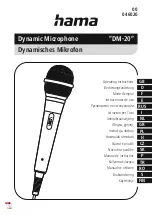
phase polarity on your microphone preamplifier to achieve in-
phase recordings when tracking on the back side of an R-122V.
Normal proximity effect (increase of bass), which is prevalent
on the R-122V and all ribbon microphones, starts to occur normally
at 4-6 feet from the microphone and increases with closeness.
Vocalists and voice-over talents often work the microphone closely
to take advantage of proximity effect, which gives an authoritative
quality or rich texture to their voice.
Cautionary Note:
It is important to note that the SPL handling capability of the
rear side of the R-122V is lower than its front side. The R-122V
is rated for 135dB SPL on its front side, but recordings on the
rear side should not exceed 115dB SPL. When tracking loud
sounds on the front side, the R-122V’s offset-ribbon design allows
ample space for rearward excursions of the ribbon element.
However, tracking on the back side causes the ribbon to move
forward towards the front side of the microphone, where the
internal dampening screen is much closer to the ribbon element.
Rear-side recordings of loud, low-frequency sounds, or vocalists
with no pop filter, can drive the ribbon into the front dampening
screen, creating noise and possibly damaging the ribbon element.
Limit back side recording on your R-122V to lower SPL sound
sources.
Care & Maintenance
The R-122V is a well-built, precision instrument. All that is
required to ensure proper operation of this microphone is to
follow some commonsense rules.
1. Avoid transducer damage by not exposing the microphone to
severe shock or vibration. If the microphone is accidentally
dropped, test it to see if damage has occurred before returning
it to service. Low output or a dull sound would indicate a stretched
ribbon.
24
Содержание R-122V
Страница 31: ...Polar Pattern Frequency Response 30 ...
Страница 32: ...Notes 31 ...








































